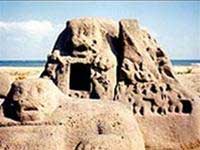Tsunami reveals the old city
 These relics have been lying for thousands of years under the sand. The December 26, 2004 tsunami helped Indian archaeologists discover a trace of an ancient port city on the beach in Tamil Nadu state.
These relics have been lying for thousands of years under the sand. The December 26, 2004 tsunami helped Indian archaeologists discover a trace of an ancient port city on the beach in Tamil Nadu state.
According to archaeologists, the relics found belong to a very prosperous port city, located in the area of an ancient temple of 1,200 years old Mahabalipuram stone.
Among the three relics, there is a lion made of marble, all buried in sand for thousands of years. And maybe they'll still be there if the tsunami doesn't turn it all up.
According to T. Sathiamoorthy, a researcher at the Archaeological Survey of India (ASI), these relics can be part of a certain temple or building. They were built around the 7th century AD and are nearly 2m high. All are elaborately carved, following the motif with the pattern of Mahabalipuram temple.
Recognized as a world heritage site, Mahabalipuram Temple is one of the earliest architectures of the Dravidian era of the 7th century. This work has many giant reliefs made of marble placed outdoors. According to legend, this temple belongs to a cluster of 7 temples, but 6 other temples were submerged under the sea. Previously, the port city here was built so beautifully that the gods envy and sent a tsunami to submerge them all in one day.
Next to the stone lion, two other relics are a half-sculpted elephant relief and a 24-centimeter bronze Buddha statue. The Buddha statue was returned to the local government, and would probably be placed in some Indian museum.
According to the BBC
- Video has never been published: The tsunami moment engulfed Indonesia's coastal city
- HOT! The 2-meter tsunami hit Indonesia city after the earthquake
- 'Find the legendary city of Atlantis'
- The soul haunts a tsunami-hit city in Japan
- Decipher the mysterious tsunami in the East Sea
- What will happen if tsunami?
- Japan warns tsunamis through animal expression
- A 60m high 'destructive' tsunami could hit Australia
- Tsunami in Indonesia killed more than 200 people
- Broken ice caused 'tsunami' in Peru
- New photo: The whole tsunami flooded Fukushima factory
- Earthquake of 8 Richter scale in Chile, tsunami warning
 Discovered an ancient centipede fossil 99 million years old
Discovered an ancient centipede fossil 99 million years old Discovered bat-like dinosaurs in China
Discovered bat-like dinosaurs in China Discovered a 200-year-old bronze cannon of the coast
Discovered a 200-year-old bronze cannon of the coast Discover 305 million-year-old spider fossils
Discover 305 million-year-old spider fossils